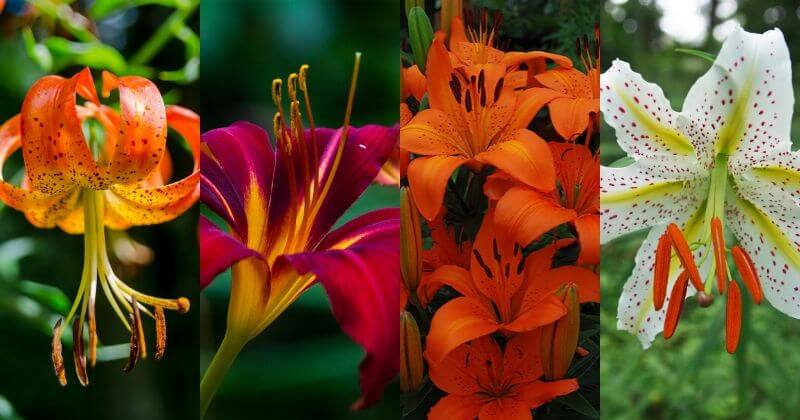
If someone asked you to picture a lily in your mind, what image would you conjure up? Likely it’s a huge, pure white, trumpet-shaped flower with big anthers full of rust-colored pollen?
Well, the Madonna Lily (L. candidum) is just the tip of the iceberg when it comes to lilies. We have a whole world of incredible lilies to introduce you to!
From the dainty, purple pendent blooms of L. martagon to the enormous, orange trumpets of ‘Enchantment’, there’s a lily out there to suit every gardener’s taste.
These slender, strong plants raise their bright, sophisticated blooms high, decorating flower beds and filling the air with a subtle fragrance.
The word “lily” is translated as “whiteness”, but the flowers have different colors and shapes. From the purest white to the darkest garnet, passing through all shades of pink, yellow and orange.
The genus Lilium has more than a 100 species, 2000 varieties and a considerable amount of hybrids which can be classified into nine ‘divisions’.
If you’re curious about what types of lilies are available, keep on reading to discover all 9 ‘divisions’ of this fabulous and diverse genus.
We’ll point you towards the very best types of wild lilies or lily cultivars from each division with pictures. We’ll also explain how to care for lilies in your own garden so they’ll provide you with dozens of dazzling blooms!
The History Of The Lily
Lilies have grown wild all across North America, Europe, and Asia for a very long time, and as civilizations grew, humans began to notice these beautiful flowers and started to cultivate them.
As Europeans began to explore far-flung continents, new and exotic lily species were discovered and brought back from America, Asia, and Japan by plant collectors.
Wild lilies were conveniently ‘pre-packaged’ as bulbs which enabled easy transportation around the world. Unlike the orchid plants also being collected from the wild, lily bulbs were likely to arrive at their destination intact.
In the 1920s, the number of lily varieties available began to increase rapidly. A hard-working lily enthusiast in Oregon named Jan de Graaff put together an impressive breeding program.
Jan de Graaff’s Oregon Bulb Farms were responsible for the birth of a vast array of popular hybrids. Many of those lilies are still around today.
Florists soon realized that these new hybrids would make ideal cut flowers, and the popularity of the lily has grown ever since.
Different Types Of Lilies With Photos
There are so many types of lilies available that it can be overwhelming for the novice gardener.
Would you like early flowering lilies? Lilies for partial shade? Small lilies for containers? Fragrant lilies for cut flowers? Take a look at our quick facts to see what each type of lily has to offer.
Our tour though each lily division will introduce to some of the classic pure white lilies, but there are also many colored lilies in gorgeous shades of yellow, orange, pink, purple, and red.
Wild Lilies (Also Known As Division 9)
We will start our journey with the last division of Lilies: the Wild Lilies. Let us explain why!
In our opinion, these original lilies are actually the most important. After all, none of the gorgeous hybrids we have today would be possible without these wild species.
The wild lilies are often overlooked in favor of their flashier hybrid offspring, but many of these species are just as lovely, and often even more characterful.
Learning about these wild lilies before we dive into the showier hybrids will help the beginner Lily enthusiast see where the traits of the various hybrids have come from.
Knowing the parent plants and their likes and dislikes can also help you predict the care needs of a new hybrid.
And who knows, you may fall in love with one or more of these wild beauties and decide to plant them in your garden!
So without further ado, let’s start introducing you to a few of our favorite wild lilies.
Wild Lilies To Grow In Your Garden
1: Lilium Martagon (Martagon Lily)
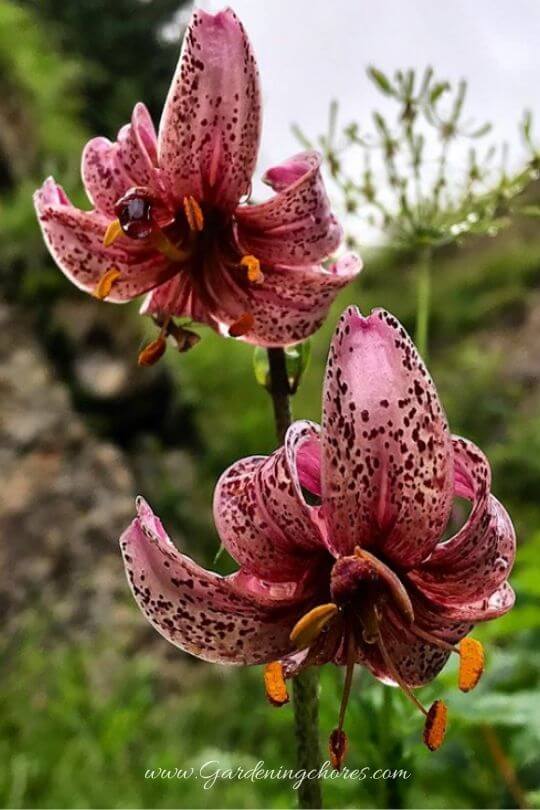
L. martagon is one of those plants that gardeners adore because of its ability to ‘go native’ and establish itself for many years (if not decades). It’s also one of the few lily species to genuinely enjoy light shade, and it has passed this useful trait onto many of its hybrids.
The original L. martagon is soft purple to pink in color but is also available in an albino white form. The pendent blooms hang down in a Turk’s Cap shape, curving right back on themselves to touch the base of the flower.
Freckles are often (but not always) present on the blooms, and the foliage is sparse. This is more than made up for by the abundant flowers, however.
L. martagon is not fussy about soils and won’t be upset if you have a touch of lime in your local area. We recommend L. martagon for a more naturalistic planting scheme, as she fits in beautifully with a cottage garden style planting scheme.
2: Lilium Canadense (Canada Lily)
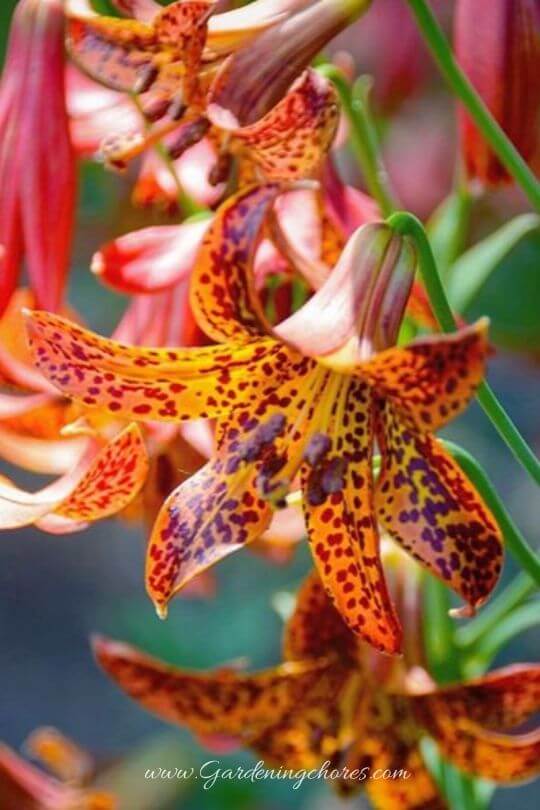
This North American species, is also known as the ‘Canada Lily’ or the ‘Meadow Lily’. L. canadense has been in cultivation for over 400 years so it’s a real old-timer!
L. canadense is one of a few lilies which have the unusual stoloniferous bulb type. This means that instead of growing from the top of the bulb, shoots grow out from the base of the bulb for a few inches. New bulbs form at the end of these shoots, and then growth starts to head to the surface.
Compared to its big trumpet cousins, L. canadense is dainty and elegant. The hanging yellow blooms have neatly pointed tips that sweep out and upwards, and the centers are lightly freckled with orange-brown spots.
The combined effect of a group of these splendid Lillies is incredibly cheerful! Unfortunately, though, it is not a good choice for lily beginners. Getting them to perform is something of a challenge.
3: Lilium Pardilinum (Leopard Lily)
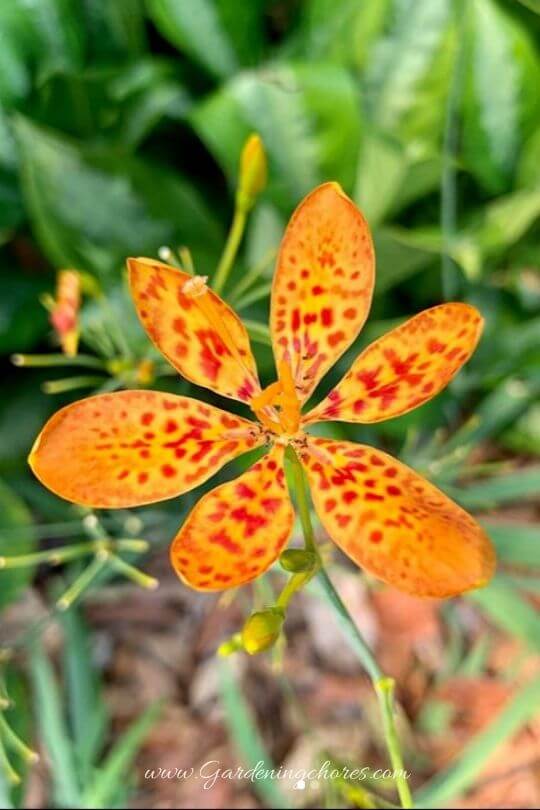
The Leopard Lily is a North American species native to the pacific coast region (California to Oregon). The pendent blooms hang cheerfully like little lanterns hanging from the long stalks.
The petals are a striking orange-red color, that gives way to golden yellow at the center. A scattering of darker spots on the yellow areas give this attractive lily its common name.
As a woodland species, L. pardalinum is actually one of the few lilies that do well in partial shade. The flower spikes reach up to six feet and they’ll form natural clumps if left to their own devices for a few years.
4: Lilium Lancifolium (Tiger Lily)
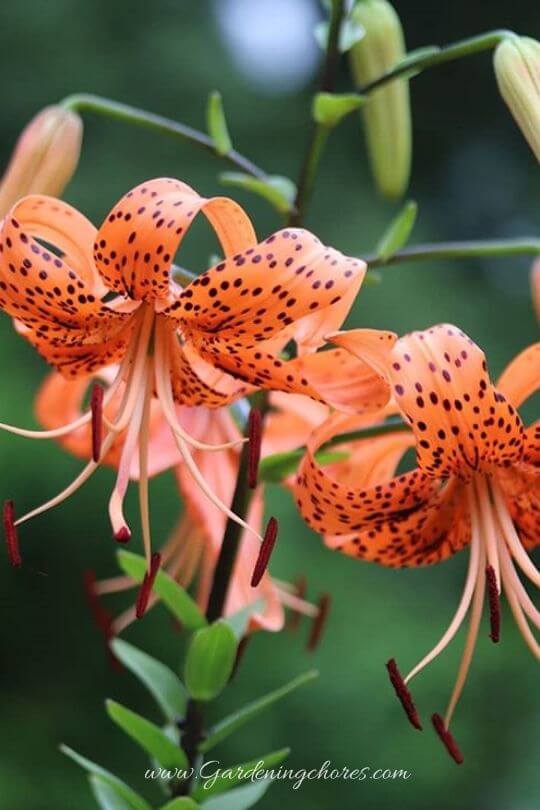
The sublime Tiger Lily originated from Asia but has now become naturalized over large parts of the US, and particularly around New England. It’s a truly prolific lily species!
The peachy orange petals curve backward to touch the base of the stalk and are decorated with very dark spots. The stems are incredibly dark (almost black) and make a striking contrast with the bright orange blooms.
If you decide you want more Tiger Lilies, you won’t have any trouble propagating them. Tiny bulbils (small bulbs) form at the axis between the main stem and each leaf. Remove them as soon as they are easy to pull away, and plant them into small pots.
The Tiger Lily is incredibly robust, and will barely notice a virus infection. This makes them a risky species to plant near other lilies so make sure you locate them a good distance away.
5: Lilium Candidum (Madonna Lily)
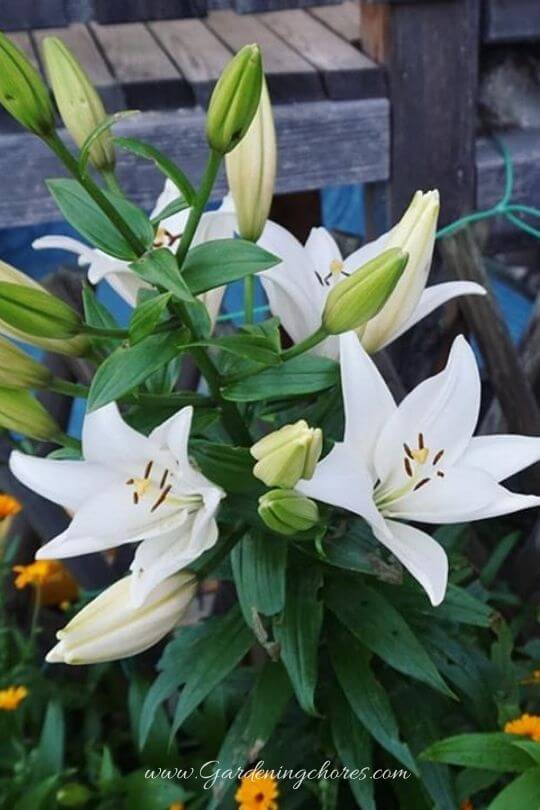
The classic white Madonna’ Lily has perhaps the longest history of all lily species. People have been growing her innocent, white blooms since before Christian times – for show and for food!
Find your Madonna Lily a sunny position, with her feet planted in well-drained soil and she should not require much attention from you. This lily is not particularly fussy about soil PH either so a bit of lime in the soil won’t prevent them from growing strongly.
The flowers have wide and large, crisp white petals, which sometimes give way to pale green in the center. The anthers are a sunny yellow color.
Top tips for Madonna lilies are to remember to plant your Madonna lily bulbs a little more shallow then you would normally. Also, plant them well away from other lilies, as they can easily pick up viruses from infected plants.
6: Lilium Speciosum (Oriental Lily)
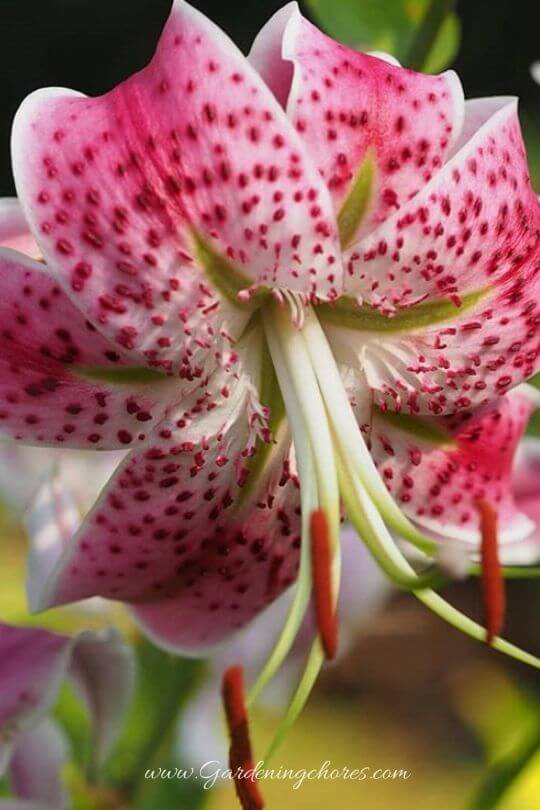
L. speciosum is originally from Japan. It’s a great species to consider if you are planning to have lilies flowering over a long time period as they are one of the few late-flowering species. Blooms, usually appear in early autumn.
The pendent flowers are either white or blushed pink and spaced far apart along the narrow stems. Each bloom is marked with raised ‘papillae’ bumps and darker pink spots.
L. speciosum despises lime, so you’ll need to grow these lilies in containers with ericaceous compost if you have alkaline soils.
7: Lilium Auratum (Golden-Rayed Lily)
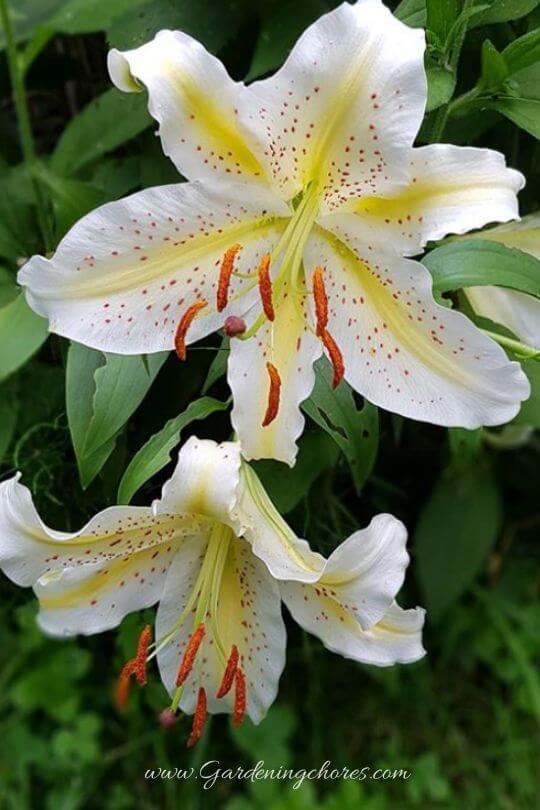
The wide-open blooms of this wild Japanese lily are a marvel, often reaching 10-12 inches in diameter! The fragrance is also something special, so you’ll want to plant them near the house so you can get up close and personal with them on a regular basis.
The soft white petals are each decorated with a yellow stripe in the centre, which creates a stunning star effect. Most varieties have a scattering of small dark spots, while others have softer pink tones across each petal.
Like it’s relative, L. speciosum, L. auratum is a lime hating species, and will much prefer a neutral to acidic soil if being planted out in the border. It does very well in containers. Just provide it with ericaceous compost with some grit added in for drainage.
8: Lilium Henryi (Henry’s Lily)
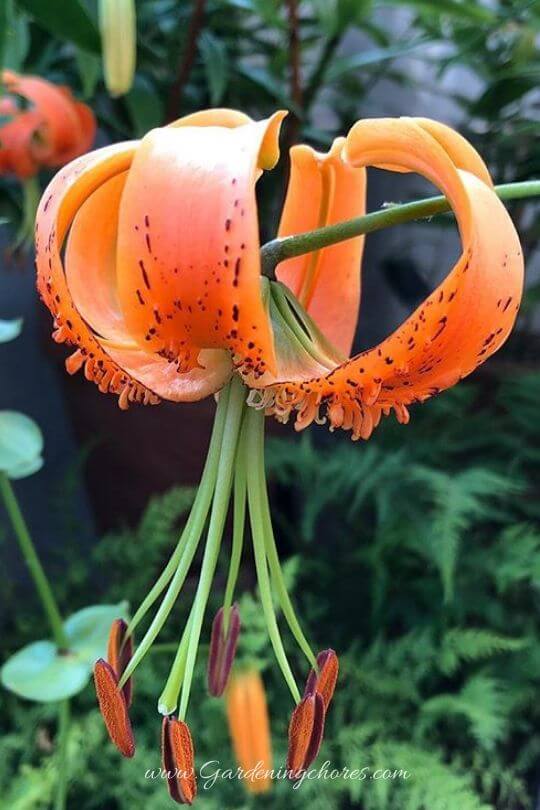
Henry’s Lily will provide you with dozens of gorgeous, tropical orange flowers. Each one is decorated with a dense pattern of raised red bumps, giving it a delightful texture.
The petals curve backward in a classic Turk’s Cap shape, trying to touch the stalks and the strong stems grow at a sloping angle. Henry’s Lily is particularly well suited to informal or natural style plantings.
L. henryi has been vital in the creation of a large number of popular hybrids. It’s incredibly robust and lives a long time, but it’s most valuable asset is its indifference to soil type.
Many fantastic hybrids can be grown in alkaline soils now thanks to L. henryi passing on its genes, including popular trumpet and oriental hybrids.
9: Lilium Longiflorum (Easter Lily)
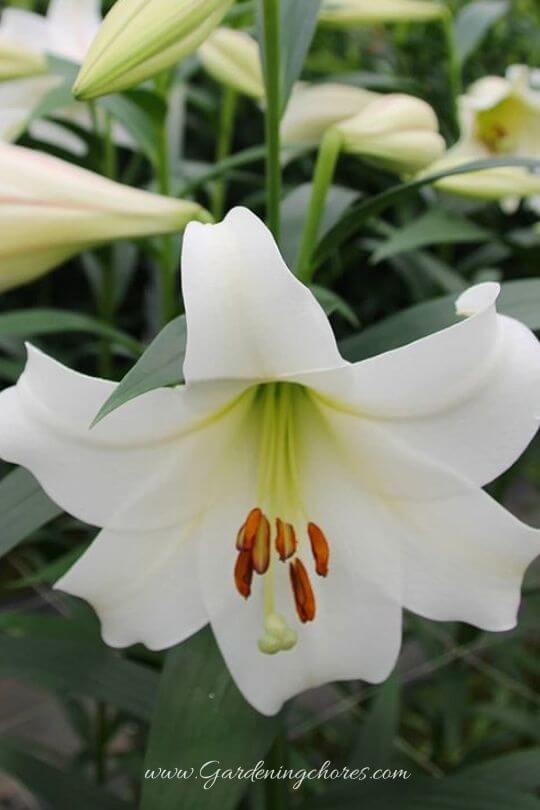
The elegant Easter Lily with its pure white, trumpet blooms, is the plant behind the creation of some super hybrids such as ‘White American’ and ‘White Heaven’.
If you live in a warm climate, you’ll be lucky enough to grow this beautiful lily outdoors. In colder climes, Easter Lilies will need to be grown under glass, or planted in containers that can be brought in for the winter.
10: Lilium Bulbiferum (Fire Lily)
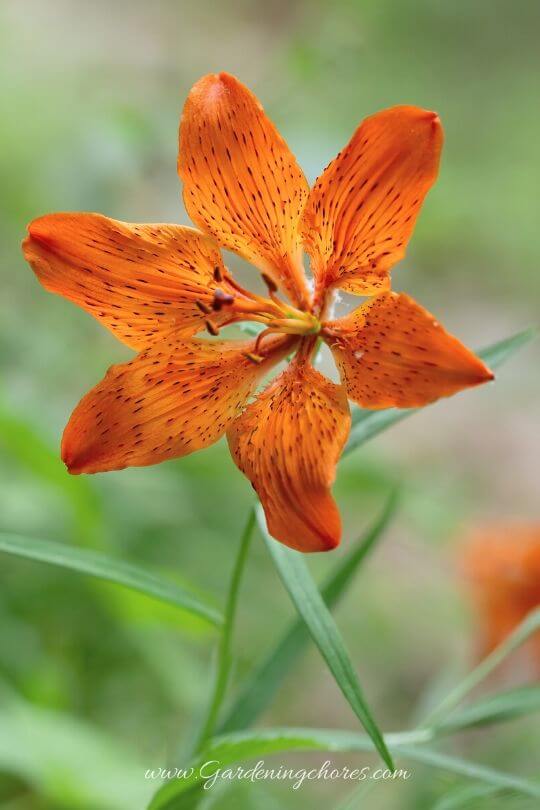
Also known as the Fire Lily, this species was first discovered growing in the mountains of southern Europe. L. bulbiferum has been used widely to produce a host of attractive Asiatic hybrids.
The Fire Lily may be on the smaller side, reaching only 30” high, but the blooms are stunning. In early summer, you’ll see wide, open bowl-shaped flowers of rich tangerine orange. The petals are decorated with darker, chocolate-colored spots.
This species is fairly easy to propagate too, thanks to the numerous bulbils (small bulbs) that form in the axil between the leaf and stem. Simply remove these when they pull away easily and pot them up.
Division 1 – Asiatic Hybrids
Though smaller in size when compared to their trumpet cousins, the Asiatics are no less beautiful. A vast array of shades and shapes are available to suit every taste and color palette, as well as many sweet dwarf options ideal for smaller gardens.
Asiatic hybrids were created by crossing mainly Asian species such as L. lancifolum (the Tiger Lily), but the division also include hybrids of L. bulbiferum which is a native of Europe.
Caring For Asiatics
Asiatics don’t tend to mind a little lime in the soil but you should ensure their location is given a generous helping of organic matter. Like all lilies, they appreciate good drainage.
You can expect blooms from early to midsummer with most hybrids. They’re likely to reach 75cm (30”) in their first year but probably less in their second.
Asiatic Hybrids To Grow In Your Garden
11: Lilium ‘Enchantment’ (Enchantment Lily)
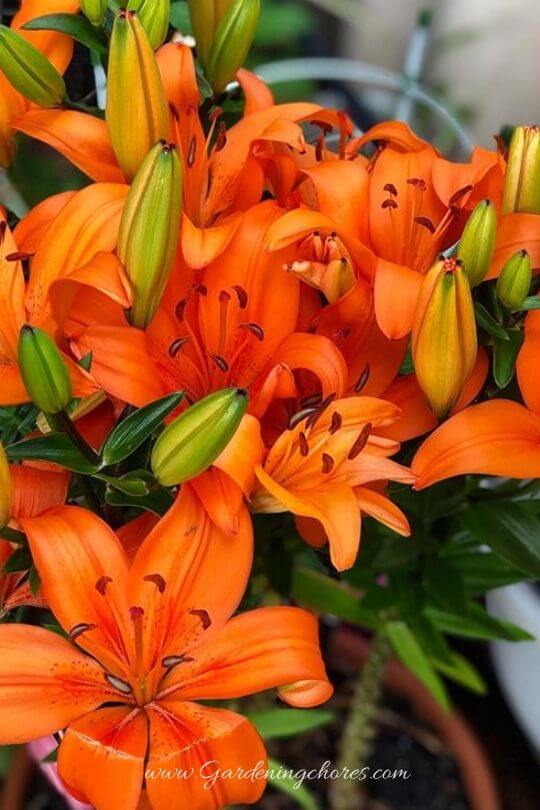
This hybrid certainly lives up to its name! A truly show-stealing flower, it’s hot and vivid orange blooms are softened with a light dusting of darker spots.
It’s a popular variety and for good reason. Enchantment is easy to grow and makes excellent cut flowers
It’s also easy to increase your plants for the future. Bulbils (tiny bulbs) will form in the apex of each leaf along the stems of nonflowering plants.
Harvest these bulbils eight weeks after flowering and pot in ericaceous (lime-free) compost to grow them on.
12: Lilium ‘Connecticut King’
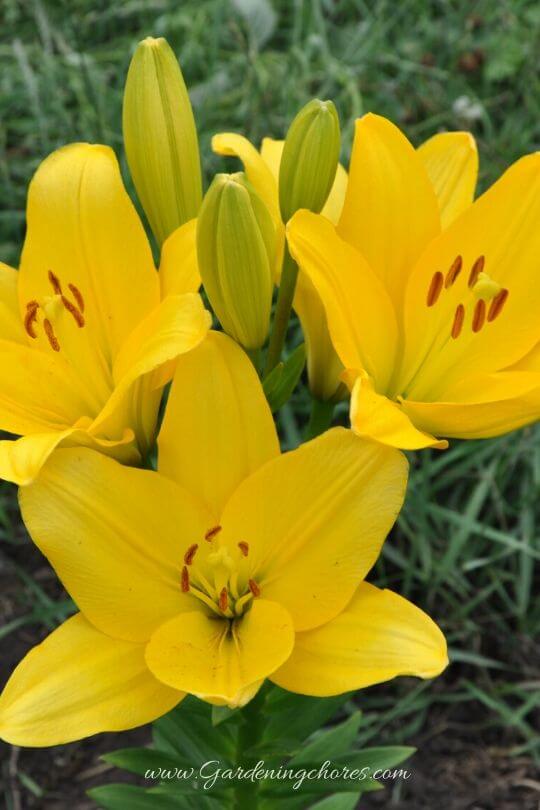
Another darling of the cut-flower industry, Connecticut King sports large golden blooms that are free from the usual spots. The foliage is a bright and contrasting green.
13: Lilium Roma
A stately and elegant lily hybrid that tends to flower later than other Asiatics. The blushed pink buds open into large creamy blooms with a delicate sprinkling of spots near the center.
A stately and elegant lily hybrid that tends to flower later than other Asiatics. The blushed pink buds open into large creamy blooms with a delicate sprinkling of spots near the center.
Dwarf Asiatics
The Asiatic lilies make such fantastic container plants that it was a no brainer for breeders to start creating dwarfs hybrids as well.
If you plan your bulb planting carefully, it’s possible to have a series of different colors appear over the spring, summer, and early autumn months.
Most popular among dwarf varieties are the Pixie series lilies, which can reach up to 16” in height. They all bloom early and make exciting additions to a decking area or balcony garden.
14: Orange Pixie Lily
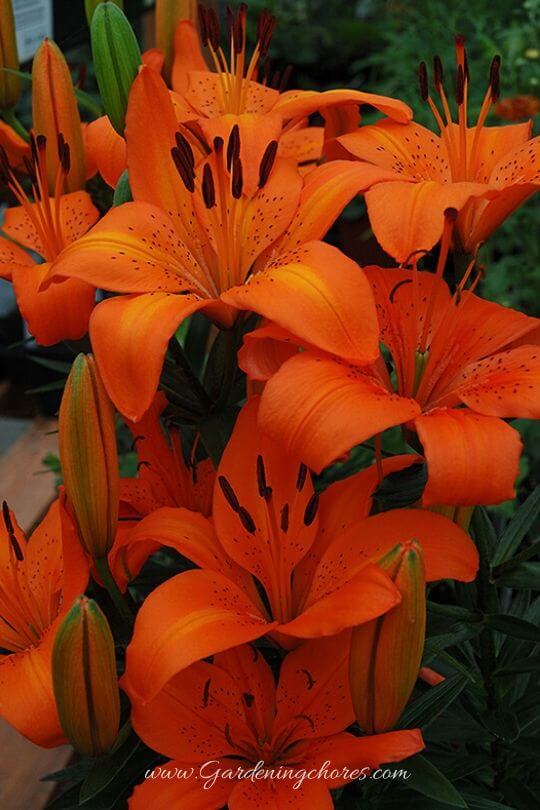
Orange Pixie is a real legend in this size category. At only eight inches high, this hybrid will still produce some stunning big orange blooms, that should perform for several weeks.
15: Denia Pixie Lily
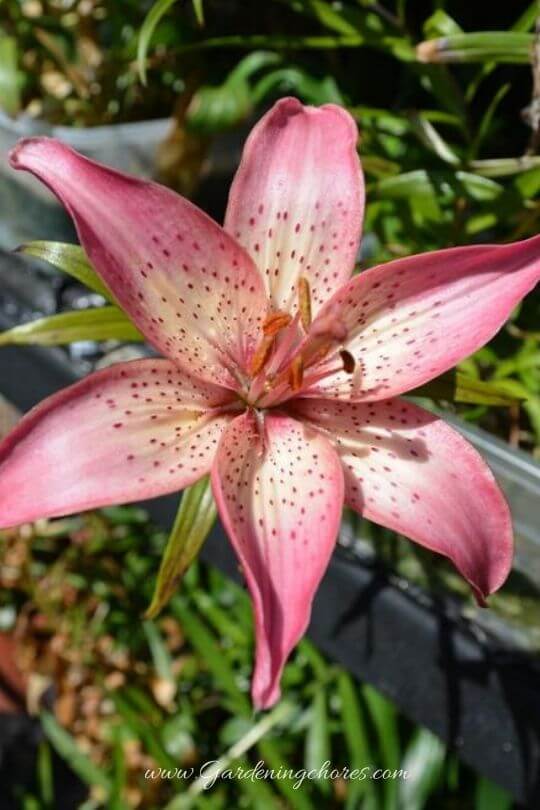
If you prefer something a little subtler, try Denia Pixie. The large, pink blushed petals are jazzed up with darker brown freckles that give these flowers tons of personality.
Division 2 – Martagon-Type Hybrids
If you think trumpet lilies are too brash and showy for your style of garden, we definitely recommend you take a good look at Martagon hybrids.
Just like the wild lily L. martagon, dainty, pendent blooms are arranged on tall spikes, with petals that curve back towards the stalk.
These varieties will fit in beautifully with a more natural style garden. If they like the conditions, Martagon hybrids may even become established and make themselves at home for decades.
Martagon hybrids are usually the result of cross-breeding L. martagon and L. hansonii. Like the parent plants, hybrids have Turk’s cap shaped blooms and foliage that whorls around the stem.
Caring For Martagon Hybrids
Martagon hybrids are not as fussy as other lilies and will grow in all sorts of soil types if the drainage is adequate.
It’s also not fussed about being in a bit of shade so they can be planted to create a beautiful display amongst a semi-wooded area.
Martagon Hybrids To Grow In Your Garden
16: L. X Dalhansonii ‘Marhan’
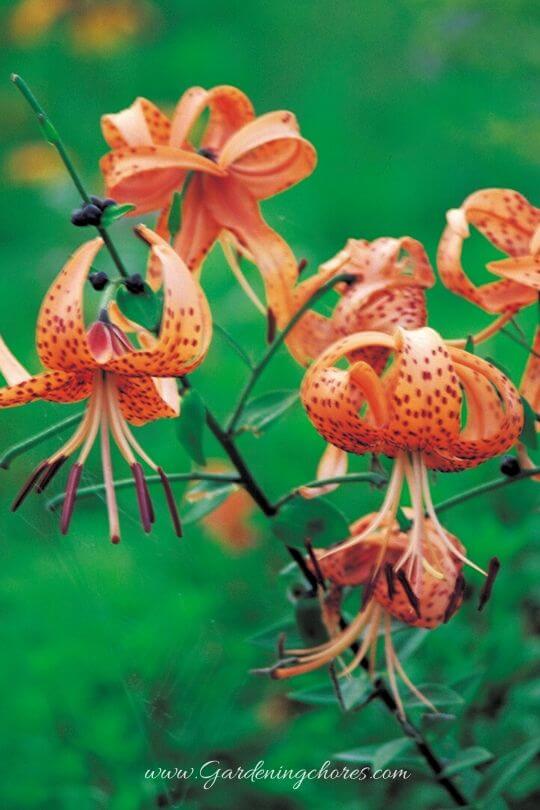
‘Marhan’ has been a popular cultivar for well over 100 years now. It bears a strong resemblance to its parents, L. hansonii and L. martagon, but with petals that do not curve as strongly.
The colors are subtle and sultry, with heavily spotted, honey-color blooms that stand out against the dark green stems.
Division 3 – Candidum Hybrids
L. candidum, also known as the Madonna Lily, is perhaps one of the most famous lilies in the world. It also has a long history of association with religion.
Strangely, the Madonna Lily has not been used to create many cultivars. L. x testaceum is virtually the only widely known hybrid, and it is hard to track down.
Division 4 – Hybrids Of American Species
Hybrids of the classic American native lilies are usually produced from L. pardalinum (also known as the Leopard Lily). They often have whorled foliage and the blooms are usually pendent.
American Hybrids form rhizomatous bulbs, meaning the bulb spreads outwards over the years to create a mat of scaly growth.
Caring For American Hybrids
The rhizomatous, mat type bulbs need to be carefully lifted and propagated, as they can be damaged by careless digging.
These hybrids tend to do well in light woodland conditions or when planted with shrubs.
American Hybrids To Grow In Your Garden
17: Lilium Bellingham
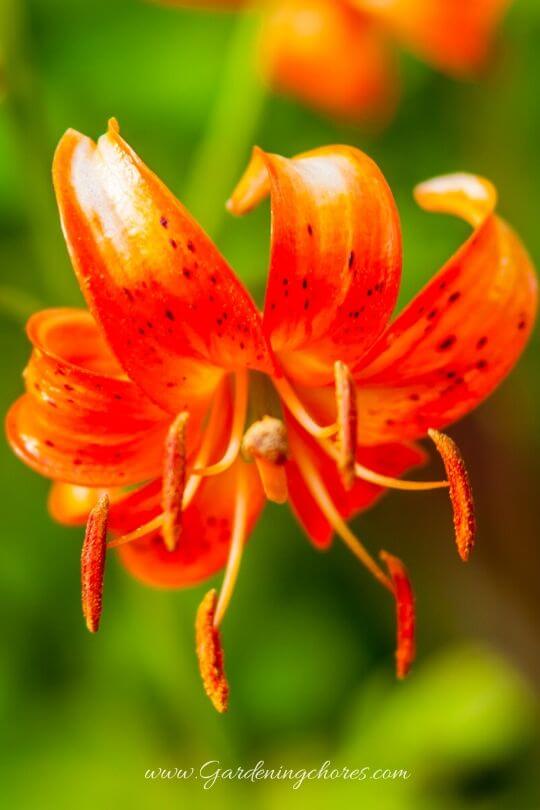
Bellingham is a vigorous lily hybrid that will soon grow into tall spikes, decorated with whorls of bright green leaves.
In the summer they’ll provide you with gorgeous, fiery colored blooms in shades of red, orange and yellow.
18: Lily ‘Cherrywood’

Cherrywood has elegant pendent blooms. A rich red at the tips of the petals shifts into tangerine towards the center of the flower, with a smattering of pretty red spots to finish the look.
Like its parent L. pardalinum, Cherrywood has whorls of foliage, spaced out along the straight stems.
Division 5 – Longiflorum Hybrids
L. longiflorum is also known as the Easter Lily and is prized by florists for its impressive, pure white blooms and delicious strong scent.
The Easter Lily has been less popular for gardeners, mostly because they are can be tender and are unlikely to survive a frost. It’s hybrids, however, have been bred to be much tougher.
Longiflorum Hybrids To Grow Yourself
19: Lilium Longiflorum ‘White American’
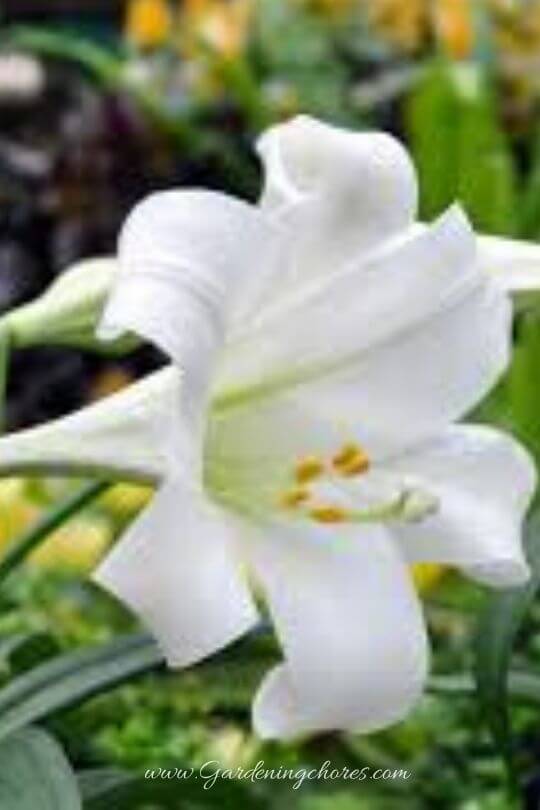
Unlike its parent plant the Easter Lily, White American is a hardy plant and grows rapidly in the right conditions. The upright stems bear dark green, lance-like leaves. The white summer blooms are trumpet-shaped with green-tinged tips and the classic rust-orange anthers.
Division 6 – Trumpet Hybrids
Trumpet Hybrids are by far the largest division of lilies, and for many, they are the pinnacle of the lily family. The classic funnel shape is the one that everyone thinks of when they first picture a lily.
The foliage on Trumpet Hybrids tends to consist of lots of narrow leaves along the stems.
Hybrids from this division are usually large, and make a bold and often colorful statement within your planting scheme. Happily, they work just as well in containers as they do in flower beds.
Huge, cheerful flowers will grace the stems of these lilies. Blooms may start to open in the early summer but they usually save their best performance for later in the season.
In addition to looking fantastic, Trumpet Hybrids also possess that gorgeous lily fragrance in abundance. Imagine catching wafts of delicious lily perfume on a still summer evening!
Caring For Trumpet Hybrids
You’ll find that your Trumpet Hybrids do best in soil that has been enriched with lots of organic matter. Once settled, their second-year performance is sure to outdo their first year and they should be happy for three to five years before they need lifting.
The bulbs do well in containers as well but make sure they are not placed too close together. A 12” gap between bulbs is about right.
After flowering, deadhead the blooms and cut the plant right back to ground level before winter arrives.
Trumpet Hybrids To Grow In Your Garden
20: Lilium ‘African Queen’ (Trumpet Lily)
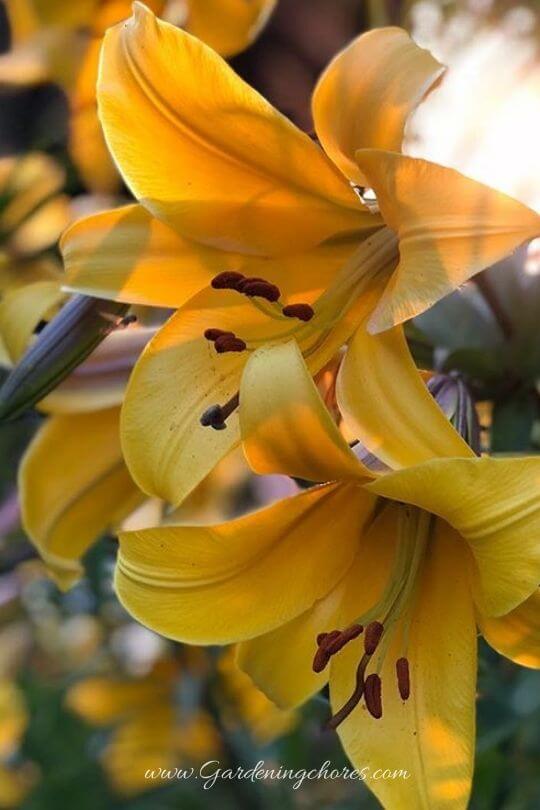
These huge orange blooms will add a tremendous tropical feel to your garden. The color is a vivid and zesty orange, tinged with soft purple-pink shades on the outer petals.
African Queen stems can reach up to six feet tall, with flowers facing outwards and slightly down. (The ideal height for garden visitors to catch the delicious scent as they stroll past!)
The African Queen group is particularly sturdy and will survive well in most climates. Just find them a nice sunny location with well-drained soil and they’ll do wonderfully.
21: Lilium ‘Golden Splendor’
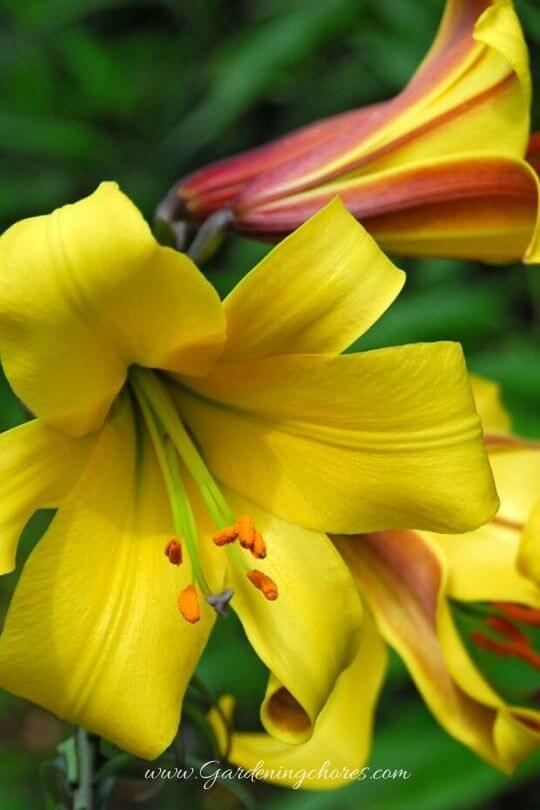
Golden Splendor lilies produce stunning, giant-sized yellow blooms. The buds are a muted purple shade, which complements the golden flowers beautifully.
Golden Splendor stems can reach up to four feet in height and as is usual for trumpet hybrids, the flowers possess a bewitching fragrance.
You won’t have to worry about these hybrids in bad weather either, as they are tough plants. They should so fine in all but the coldest climates.
22: Lilium Pink Perfection Group
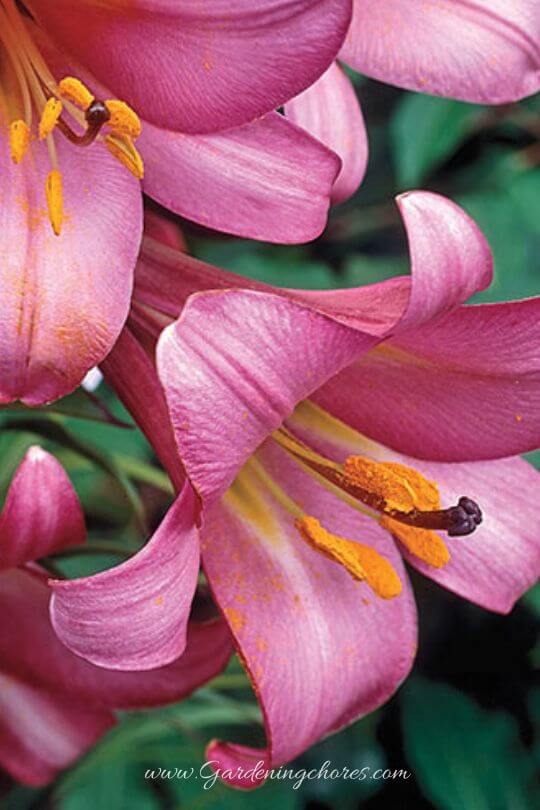
If you love dramatic, dark pink or purple flowers, you’ll want to check out this group of trumpet hybrids. Pink Perfection’s blooms are absolutely enormous, often measuring up to 10” in diameter!
This award-winning lily group is much loved for its incredible fragrance. Plant them in any border or bed for an incredible display of color and scent that should last many weeks.
Pink Perfection lilies do just as well in a container garden as out in the flower beds, and the blooms make fantastic cut flowers.
23: Lilium ‘Bright Star’, Lily ‘Bright Star’
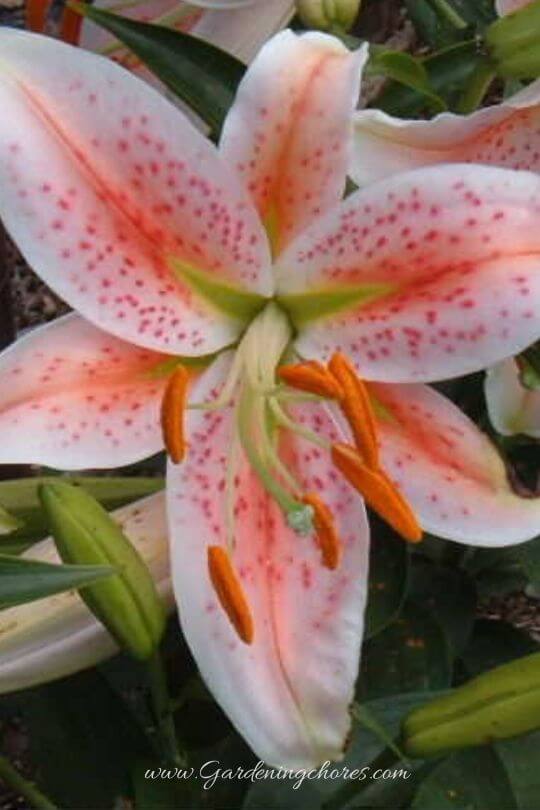
These big and bold white flowers are splashed with bright orange in the center of the blooms. The resulting star-like effect is what gives them their name and their cheerful character!.
The shape is somewhat flatter than the other trumpet varieties, due to ‘Bright Star’ being a cross between the trumpet lily L. centifolium and L. henryi. ‘Bright Star’ and similar, flatter types of lily from these pairings are also known as ‘sunburst’ lilies.
If you take a closer look at your ‘Bright Star’ blooms, you’ll see that within the central golden star lies an even smaller light green one formed by the nectary furrows, right at the heart of the flower.
Jan de Graaf of the famous Oregon Bulb Farms was responsible for the creation of this stunning hybrid back in the 1930s.
Division 7 – Oriental Hybrids
The wild Japanese beauties L. auratum and L. speciosum (see our wild lily section above) were the two lilies behind the creation of most Oriental Hybrids we see today. The resulting plants succeeded beyond anyone’s expectations.
Oriental Hybrids inherited all of the beauty and fragrance that their parents were famous for but turned out to be a lot more robust. The flowers reach impressive sizes, and bear petals that are slightly recurved (bent backward).
Caring For Your Oriental Hybrids
The majority of these hybrids are lime-haters, so if you are stuck with very alkaline soil you may have to resign yourself to keeping them in pots full of ericaceous compost. Luckily, Oriental Hybrids do incredibly well in containers if given ericaceous compost.
Oriental Hybrids To Grow In Your Garden
24: Oriental Lily Acapulco
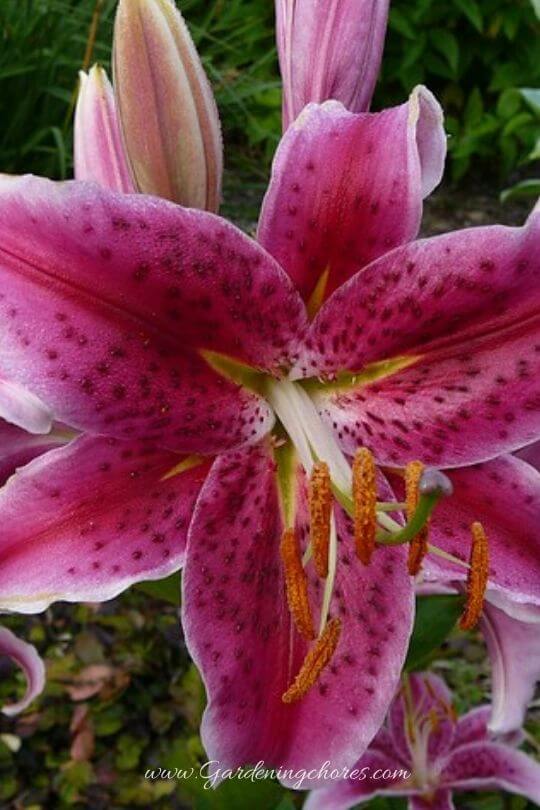
This is the ultimate lily for all the pink lovers out there. Its stunning blooms are a uniform, glowing cerise, not unlike the shade favored by the traditional Barbie doll!
The center of each flower has a dusting of darker pink spots and the outer petals are slightly ruffled, softening the profile. Acapulco possesses a delightful fragrance and is perfect for bouquets.
25: Lilium Casa Blanca
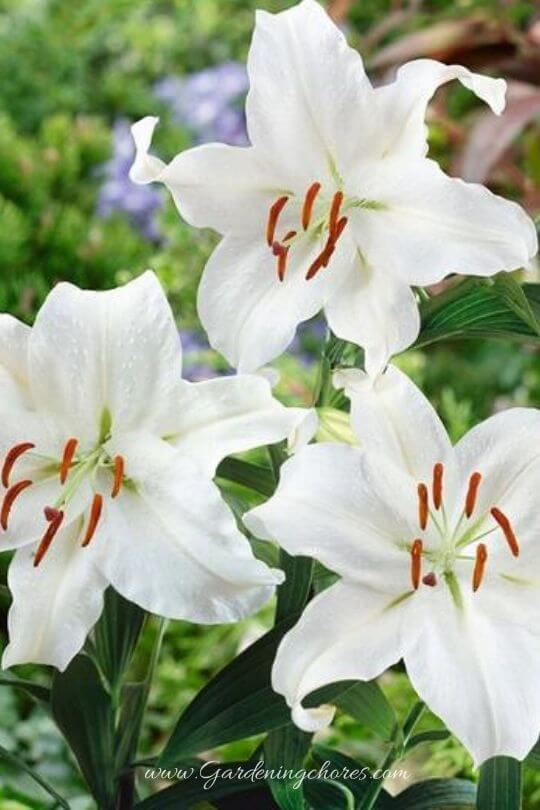
A stunning Oriental Hybrid with enormous snow-white blooms, ‘Casa Blanca’ is often used for cut flowers. The center of each bloom is usually tinged with a delicate green.
It’s easy to see why this beauty has become a popular sight in gardens around the world. Plant ‘Casa Blanca’ towards the back of a sunny border and enjoy!
26: Lilium ‘Dizzy’
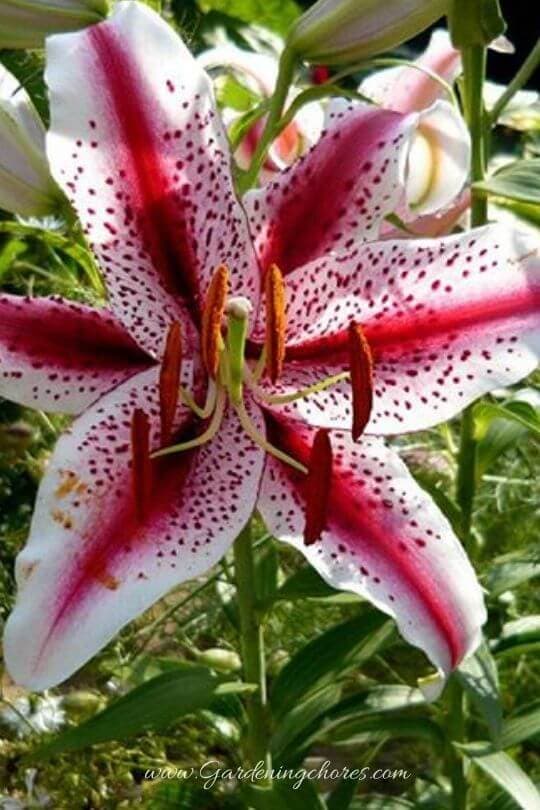
‘Dizzy’ is a super cute oriental with big white flowers that are beautifully decorated with deep red stripes and spots. The petal edges curve backward and are slightly ruffled, which only adds to Dizzy’s charms.
‘Dizzy’ will do best in well-drained soils but make sure the ground never dries out completely.
Pop ‘Dizzy’ into a sunny flower bed or she’ll be equally happy in a container. You’ll want to make sure this plant is close to a seating area, so you can appreciate the heady perfume in summer.
Similar to ‘Dizzy’ but with more pink on the petals is another stellar hybrid called ‘Star Gazer’. Or you could try the dwarf cultivar ‘Mona Lisa’ if you prefer a smaller lily.
27: Lilium ‘Tom Pouce’
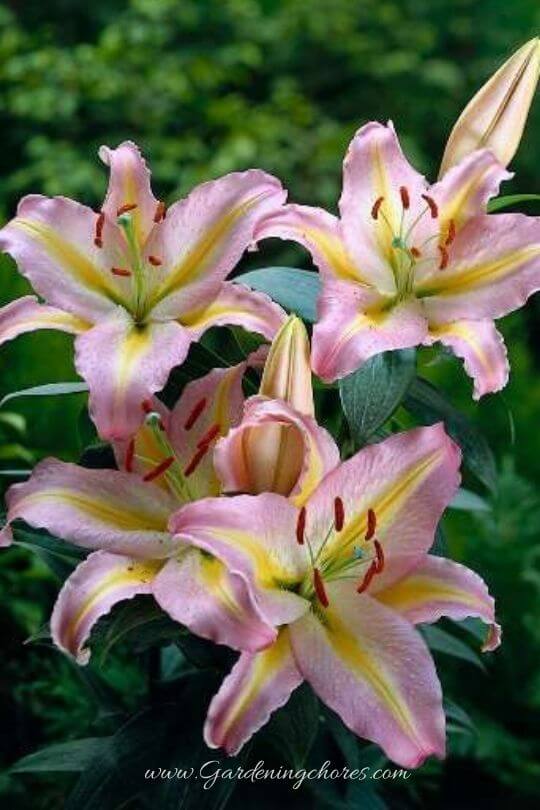
On the more subtle end of the lily color spectrum, ‘Tom Pouce’ bears delicate pale pink and cream blooms, dusted with some darker spots.
‘Tom Pouce’ will do well in almost all types of soil as long as it is well-drained. These bulbs also perform admirably in containers and will provide you with plenty of gorgeous flowers for cutting. The blooms will regularly reach 8” in size or larger!
Division 8 – Inter-Divisional Hybrids
These inter-divisional hybrids are hybrids of lilies that could not be crossed in the past. Thanks to scientific advances, breeders have been able to introduce a wide range of new options for lily lovers in recent years.
Classic lily problems, such as their dislike of lime in soils, have been solved with many of these new hybrids. These ‘impossible’ hybrids have also created some really unusual new flower forms.
Let’s take a look at some of the new lilies. First up are the LA hybrids, which cross L. longiflorum with Asiatic lily species. After that, we’ll take a look at some Orienpet hybrids which cross Oriental lilies with Trumpet species.
LA Hybrid Lilies To Grow In Your Garden
28: Lilium ‘Forza Red’

‘Forza’ is the Italian word for power, and the decadent, dark red blooms of this LA Hybrid certainly live up to the name. The entire flower is the same solid shade of shimmering maroon.
Its L. longiflorum heritage is responsible for the impressively large blooms. It’s no surprise that ‘Forza Red’ is an incredibly popular flower for florists.
28: Lilium ‘Heartstrings’
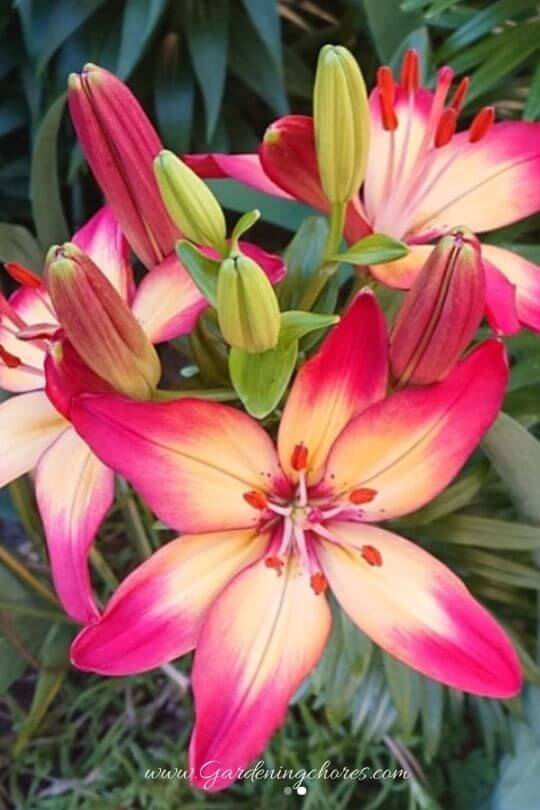
The delicate, pale yellow flower center of ‘Heartstrings’ makes way for bold pink towards the petal tips.
Give this LA hybrid a spot where it will get plenty of sun and some well-drained (but never dry) soil and ‘Heartstrings’ will provide you with plentiful, fragrant blooms for many weeks in early summer.
Orienpet Hybrid Lilies To Grow In Your Garden
29: Lilium Black Beauty
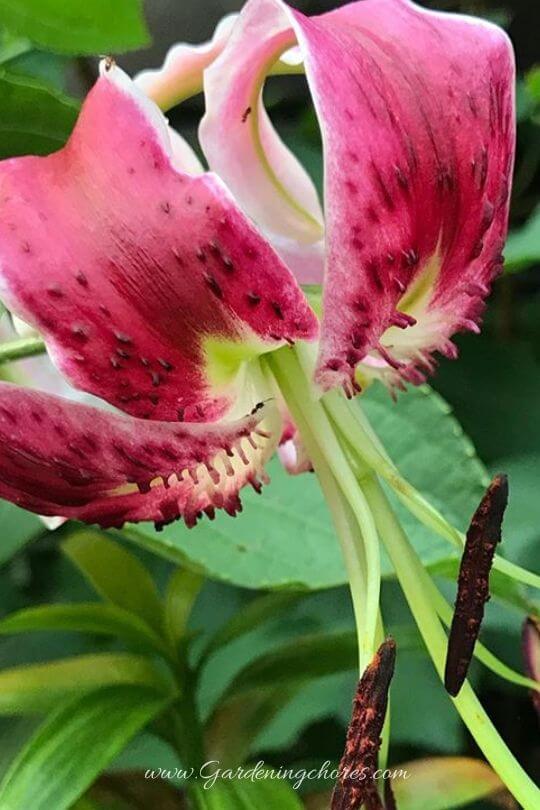
If you are after the maximum number of flowers per buck, Black Beauty will not disappoint! It will likely bear at least 50 flowers per head, and sometimes may even up to 100 or 150 flowers!
The supersize bulbs help support the heavy load of buds and flowers. Each flower is a dark crimson on the outer petals but with a lime green, clearly defined star in the center.
Black Beauty is one of the few Oriental Hybrids that can tolerate more alkaline soils. Thanks to inheriting some traits from L. henryi, Black Beauty won’t throw a tantrum if planted in a soil with some lime.
30: Lilium ‘Scheherazade’
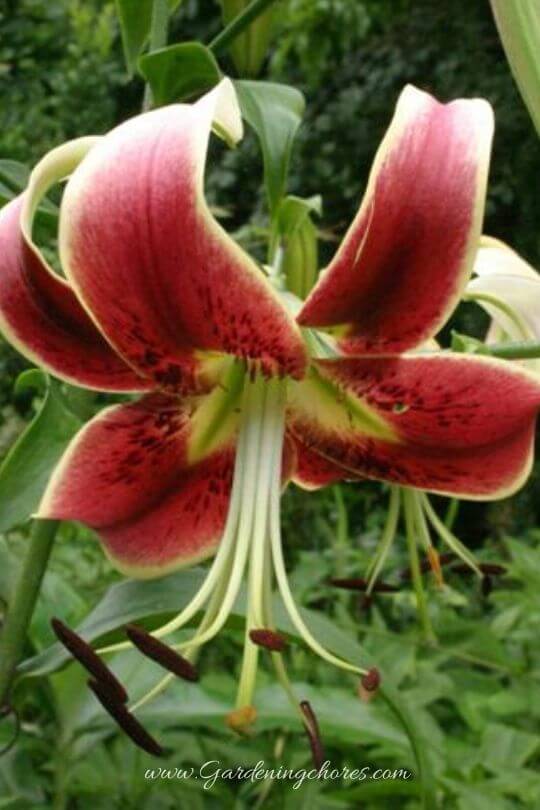
‘Scheherazade’ is sure to cast a spell on you the first time you see it. It’s grand flower spikes full of gently nodding blooms can reach up to 7 feet tall!
The flowers themselves are a rich crimson, with a border of pale cream. With the sun shining through the garden, this adds a glorious halo effect around each bloom.
The huge, dark anthers are a feature in themselves, standing out from the main flower by several inches. It’s not uncommon to see up to 40 blooms on a single stem of ‘Scheherazade’.
How To Breed Your Own Lily Hybrids
You don’t have to leave the creation of new hybrids to the experts. It’s actually quite easy to have a go yourself. Here’s our simple step-by-step guide to breeding your very own lily hybrid!
Step One
Pinch off the anthers of the lily flower you are going to pollinate (the ‘seed parent’) using tweezers or your fingers, but leave the central style in place. (The style is the long stalk-like arm between the anthers with a rounded end and no pollen).
Do this before the pollen has started to come loose from the anthers. (You can save the pollen to pollinate a different flower later, but right now you just want to prevent the plant from self-pollinating).
Step Two
Remove the anthers from the second lily plant (the ‘pollen parent’), and transfer the pollen granules onto the end of the style (the ‘stigma’) of the seed parent. It’s best to use something very soft, such as a watercolor paintbrush. If the surface of the stigma feels a little tacky, that’s a good sign as it’s likely to be receptive.
Step Three
Once you have pollinated the flower, make sure you pop a tag onto the plant to remind you which species it was crossed with. Usually, when writing down the cross you put the seed parent first, then an ‘x’ followed by the pollen parent.
If the two plants you want to pair together are not likely to bloom at the same time don’t worry. Simply pop the collected pollen into your fridge. It should stay fresh for many weeks and can be brought out again when the second plant starts to flower.
Step Four
You may have to wait several weeks for the seed pods of the fertilized lily to ripen.
If you want to be ultra-cautious, or you think you may forget to collect the seed, wrap a bit of muslin or breathable material around the pod. The seeds will stay safe in the bag rather than disappear into the ground.
Step Five
Once you have collected your seed, blow away the dead seed chaff gently. You can plant your viable lily seeds straight away into a neutral or ericaceous seed compost.
Place your seeds on top of the compost and give them a very light covering of compost or perlite (only 3mm or so). Soak the propagator in water from the bottom, until the compost looks moist on top.
Enclose the whole tray in a plastic bag. In just a few weeks your tiny lily seedlings should start to appear!
The Marvelous World Of Lilies
We hope you’ve enjoyed our whistle-stop tour of all the incredible lilies out there. There really is a variety for every taste. From the 8ft monsters with massive 10inch blooms to the adorable little dwarf hybrids, just perfect for a balcony garden.
Lilies really are an easy plant to grow. Even if you find yourself with a mystery lily, remember the general rules of providing well-drained, lime-free soil in a sunny location and they should do just fine.
If you decide to try your hand at breeding some of your very own lily hybrids do get in touch and let us know how they turned out!

Written By
Amber Noyes
Amber Noyes was born and raised in a suburban California town, San Mateo. She holds a master’s degree in horticulture from the University of California as well as a BS in Biology from the University of San Francisco. With experience working on an organic farm, water conservation research, farmers’ markets, and plant nursery, she understands what makes plants thrive and how we can better understand the connection between microclimate and plant health. When she’s not on the land, Amber loves informing people of new ideas/things related to gardening, especially organic gardening, houseplants, and growing plants in a small space.

What causes Lillies to get brown leaves, in spite of having loads of flowers?
The reason peace lilies have brown leaves can be because of temperature fluctuations, sun burn and dry soil due to underwatering.
I have Lilly’s that melt within 24 hrs why???
Amber Noyes. Scheherazade is hardy to zone 3. I have several after years of dividing the bulbs and placing them in different parts of my yard. I am in far northwestern Minnesota, the coldest part of zone 3. Scheherazade is my favorite lily. It is spectacular and lasts a long time opening about 35 blossoms even in dry years.
Our Daylillies have very healthy, full green foliage but the blossoms are few and don’t last long. Not sure of the variety, possibly Stella d’Oro. They’re well established, several years old and get full sun (Colorado – Zone 5b).
My only guess is perhaps more water is needed. But if so, why are the leaves so healthy?